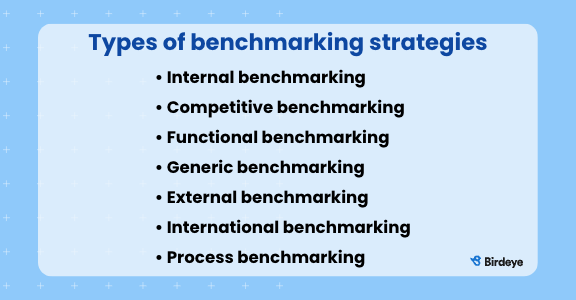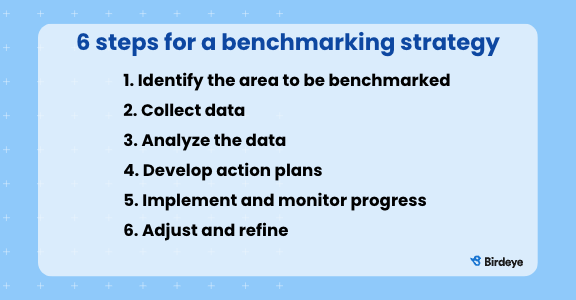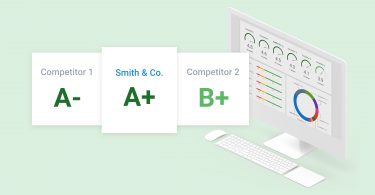Benchmarking drives greatness. Consider the four-minute mile. Experts thought it impossible that anyone could run a mile so fast, that is until Roger Bannister did so in 1954. Since then, roughly 1500 people have achieved “the impossible,” and it’s pretty much the benchmark for becoming a world-class runner.
In the same way, a benchmarking strategy can propel your company to achieve your loftiest goals. In this article, we’ll break down different types of benchmarking and leave you with six easy steps to create your own benchmarking strategy.
Table of contents
What is benchmarking?
Benchmarking is comparing any aspect of your company — processes, product quality, delivery times, to name a few — with a reference point. The best benchmarking process uses a reference point that is a bit of a stretch goal that, when achieved, will make your company better. In this way, strategic benchmarking is all about continuously improving your business.
Why is a benchmarking strategy important?
A benchmarking strategy is the main ingredient for your strategic management formula. Rather than just making goals that seem like a good idea, you’re looking to see what others have done. Then, you rework their methods for your own success.
With strategic benchmarking, you can discover ways to improve customer satisfaction, gain a competitive advantage, or bring about superior performance in any business function. That’s why people have always used benchmarking.
For example, the transcontinental railroad came about when the U.S. government used internal benchmarking to compare the fast, rail-based postal delivery in the East to the slower delivery on horseback in the West. Today’s fast-food restaurants benchmark their process against the industry standard developed by the McDonald brothers. And remember “New Coke?” That came about when Coca-Cola benchmarked its product quality with Pepsi’s.
Types of benchmarking strategies

There are several different types of benchmarking strategies. But they all have one core thing or element in common — they pit your organization’s metrics against a standard with the aim of improving your success.
Internal benchmarking
Internal benchmarking uses a reference point within your own organization as a standard for other locations, departments, or teams. If a group within your company has developed a winning strategy for doing things, you can use internal benchmarking to make the improvement company-wide, much like how the postal service made changes to mail delivery in the West.
“With Birdeye, we are able to measure and benchmark performance against our multiple properties in one easy-to-use dashboard.”
Chris Neumann, Orgin Investments
Competitive benchmarking
You can use competitive benchmarking to mine ideas from your competitors to improve something within your own company. But competitive benchmarking isn’t about copying your competitors. Rather it’s about comparing their performance to your own. Then using what you’ve learned to improve the way you do things while still offering something unique to your customer base.
Functional benchmarking
You can use functional benchmarking to take a look beyond your industry to enhance a specific function of your business, such as marketing or accounting. The company you choose to examine in your benchmarking process can offer products strikingly different from yours. Functional benchmarking often uses recognized standards. For example, accounting standards have been developed that apply across industries that, when used, guarantee quality and consistency.
Generic benchmarking
Many times, companies from different industries share a common process. Examples would be an employee application process or an employee wellness program. You can use generic benchmarking to make improvements to the processes you have in common with other companies. Generic benchmarking is useful if the company you’re analyzing shares some characteristic of your own, such as being in the same city.
External benchmarking
You can use external benchmarking to discover a lot about where your company ranks within your industry. So-called industry standards exist for a wide range of businesses. Financial services, transportation, and healthcare are all examples of industries that have adopted a defined set of industry standards.
External benchmarking doesn’t have to be just about formal industry standards. Whatever type of business or niche you occupy, you can find information about the average performance metrics of other companies similar to yours. You can use those metrics to determine areas in which you can improve.
International benchmarking
Globalization means you’re competing with companies on the other side of the world. Oftentimes, these companies manufacture products less expensively. You can use international benchmarking to find out why. You won’t always be able to replicate their methods of cheap production (or you may not want to.) But you can always use the information you get from your benchmarking process to develop a blueprint for strategic planning.
Process benchmarking
Sometimes, there’s a process within your company that you need to work on. Perhaps your operation isn’t as efficient, or your deliveries are just too slow. You can look to companies outside of your industry for ways to deliver superior performance. Process benchmarking is a way to compare your methods to another company using similar metrics, even if that company’s product isn’t anything like yours.
Back in the 80s, Motorola received plenty of customer complaints related to delivery issues. To correct the problem, Motorola looked to two companies that looked nothing like the electronics manufacturer — Domino’s Pizza and Federal Express. Both of these reference companies were known for their fast delivery process. As a result of its creative process benchmarking, Motorola succeeded in improving delivery time and increasing customer satisfaction.
6 steps for creating a benchmarking strategy

Benchmarking strategies can take on many different shapes. But they all inherently share the same basic steps. Get the most from your benchmarking process by following the steps below.
1. Identify the area to be benchmarked
Trying to benchmark every nook and cranny of your business is as effective as throwing spaghetti at the wall. Instead, start your benchmarking process by identifying what area, exactly, you want to improve upon. Perhaps, like Motorola, customer feedback has uncovered a glaring problem. Or maybe you’ve slipped in market share and want to know what the company surpassing is doing right. Find the specific area and determine the KPIs that will provide the insight you’re looking for.
2. Collect data
Next, you need to collect data. It sounds simple enough. However, it’s still a bit tricky to uncover the information you need, especially if you’re engaging in competitor research. You could reference your previous competitive analysis. Or you can comb the internet for publicly available information, such as financial records or marketing campaigns. Benchmarking software can assist you by collecting data almost instantly from thousands of sites.
3. Analyze the data
Now, at this stage of benchmarking, it’s time to make sense of all that data. If you’re only tracking a few KPIs, like maybe sales figures for performance benchmarking, a simple spreadsheet may do the job. If you want deep understanding, on the other hand, benchmarking software can create visuals that are easy to understand and update in real-time. Either way, it’s important that you glean as many insights as you can from the data you collect.
4. Develop action plans
This is where the benchmarking rubber meets the road. After all, there’s only one reason to undertake the benchmarking process, and that’s to improve your business. Once you’ve analyzed your data, you’re ready to do just that by developing an action plan. Remember, benchmarking isn’t about copying the other guy’s tricks. It’s about taking their best ideas and adapting them for your own success.
5. Implement and monitor progress
Develop an objective measure of your action plan’s success. Then, make sure each stakeholder understands their role in that success. Also, define a time frame for implementing your action plan and establish check-ins to monitor your team’s progress.
6. Adjust and refine
Top companies never stop gauging where they stand. In the same way, you always need to map out where you are compared to your industry, your competitors, or even yourself last year. Move on to the next benchmarking process once you reach one set of goals.
FAQs about benchmarking strategy
All the strategic benchmarking you do in business boils down to four major types, internal, external, practice, and performance benchmarking.
To create a benchmarking strategy, decide where you want to improve and collect the data. Crunch the numbers and make a game plan. Track your progress. If needed, change it up. Wash, rinse, repeat.
Benchmarking is comparing your organization to a standard with an eye for improvement. That standard can come from almost anywhere — as long as it results in your company being better.
An example of benchmarking would be comparing customer service metrics such as response time and customer satisfaction scores with those of competitors.
Improve your performance with Birdeye’s benchmarking software
Benchmarking is a powerful tool that can help you identify areas of improvement and develop data-driven strategies to capitalize on them. With Birdeye’s benchmarking software, you can easily compare sentiment for your offering against industry leaders, so you know exactly how you measure up. Click the banner below to learn more about Birdeye and start taking advantage of this valuable resource today.

Originally published









